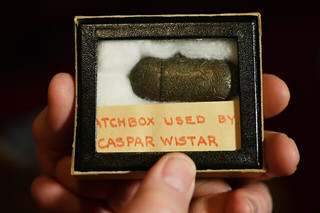
PREV ARTICLE
NEXT ARTICLE
FULL ISSUE
PREV FULL ISSUE
CASPAR WISTAR'S ODD COLLECTIONAnother good read for the collectors in all of us is this Washington Post piece published today about the strange medical artifacts a man inherited long ago from his aged godmother. -Editor
I suppose someone who lived in a normal city, maybe Akron or Omaha, would have nervously laughed off Ledge's question and started talking to someone else. But in Washington, where we practice what Abraham Lincoln called our Sometimes those relics come in the form of a wrinkled diary or a presidential Bible, stored in backrooms at the Library of Congress. Other times they come to us through medical waste. At this point, you should probably understand that, despite being one of the least pretentious people I know in Washington, Ledge is the progeny of one of America's oldest and most accomplished families. His given name is Ledyard Stevens Rhinelander King, and his ancestors include Peter Stuyvesant, the last Dutchman to oversee New York, and the Puritan minister Roger Williams, who founded Rhode Island, along with three witnesses to the Magna Carta. Another relative, Gen. Ebenezer Stevens, served on the Marquis de Lafayette's staff and is depicted in a painting in the Capitol Rotunda. It was hard to make sense of the objects we pulled from Aunt Judy's box as we sat at Ledge's kitchen table. There was an ancient portable writing desk, inside of which we found a pair of glasses that probably dated back to the 1700s. There was a giant metal key to one of Philadelphia's first jails and a shard of wood from the tree where William Penn signed his treaty with the Lenape tribe in 1683. The only hint as to the provenance of these things — including a lifelike heart made in the 1700s by Abraham Chovet, a French pioneer in anatomical models — was that much of it seemed connected to Caspar Wistar, an 18th century Philadelphia doctor. Wistar wrote the first anatomy textbook in America. His great-nephew Isaac, a lawyer and Civil War general, endowed the Wistar Institute in Philadelphia, housing a museum for rare medical artifacts. Some of those artifacts, it seemed, had found their way to Aunt Judy's shabby apartment. But how?
To read the complete article, see:
Wayne Homren, Editor The Numismatic Bibliomania Society is a non-profit organization promoting numismatic literature. See our web site at coinbooks.org. To submit items for publication in The E-Sylum, write to the Editor at this address: whomren@gmail.com To subscribe go to: https://my.binhost.com/lists/listinfo/esylum All Rights Reserved. NBS Home Page Contact the NBS webmaster 
|

